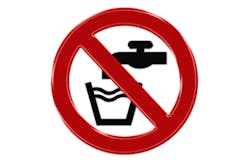What it is:
- Arsenic is element 33 in the periodic table with an atomic weight of 75. Natural arsenic is the stable isotope that contains 33 protons and 42 neutrons.
- Arsenic is found in oxidation states of -3 (arsenides), 0 (elemental arsenic), +3 (arsenite and arsenic trichloride) and + 5 (arsenate) so it can exist in many inorganic and organic compounds (e.g., methylarsonic acid and its salts).
- It is a metalloid, neither a metal nor a non-metal.
- Arsenic was formerly used in wood preservatives.
- Paris Green, perhaps the first commercial pesticide, is a copper arsenite and copper acetate complex prepared in 1814 and used as a general insecticide and rodenticide.
Occurrence:
- Arsenic is widely distributed in the earth’s crust. It is found in groundwaters as arsenite (AsO3-3) or arsenate (AsO4-3) salts. World water concentrations range from less than 1 µg/L to multiple mg/L amounts. There are pockets of high arsenic levels in groundwaters in the northeast and western U.S. as well as other locations.
- Arsenic is found in foods with fish and shellfish being by far the largest contributors to daily diet. About 99 percent of the seafood arsenic is in, is in organic forms that are likely less toxic than the inorganic forms.
- It is common in cereals, poultry, grains and vegetables with only trace amounts in milk. Rice can contain on the order of 6.7 µg of inorganic arsenic per cup depending upon where it was grown. Rice is grown in water so it has a greater opportunity to accumulate arsenic from the environment.
Health effects:
- Arsenic is acutely toxic, but it also has chronic toxicity and it is a human carcinogen.
- Inorganic arsenic (arsenate and arsenite) are considered to be greater risks than the organic forms that predominate in the diet.
- Skin, bladder and lung cancer have been identified from exposures to inorganic arsenic at high water and dietary exposure levels, e.g. Bangladesh and Taiwan.
- In Bangladesh, for many years the World Health Organization and others had provided thousands of drinking water wells so that microbially contaminated surface waters would not be used. However, unfortunately, it was later discovered that many of the wells were heavily contaminated with natural arsenic, resulting in high incidences of cancers in the exposed populations.
- A 2013 study found no correlations between total arsenic and inorganic arsenic and total cancer risk in Japan. There was a small correlation between total and inorganic arsenic dietary intake and lung cancer with male smokers.
Regulation:
- Arsenic had been regulated in the U.S. at 50 µg/L. That standard was lowered to 10 µg/L in 2001.
- The predominant impact of the standard has been in 3,000-4,000 small groundwater supplies serving about 11,000,000 people that exceed the MCL.
- All arsenic pesticide registrations in the U.S. have either been or are being cancelled.
Measurement
- Commonly available methods for analyzing arsenic in water include ICP-MS (detection limit ~0.1 µg/L) and the older hydride generation Atomic Absorption, and flame Atomic Absorption (detection limits ~ 1-2 µg/L).
- There are numerous easy-to-use test kits that allow quick on-site colormetric measurements that can readily detect amounts below 5 µg/L.
- They are particularly useful as a presence-absence type test for screening and when monitoring performance of treatment technology.
Water treatment:
- Conventional coagulation can achieve less than 10 µg/L in public water plants using either alum or ferric salts.
- Coprecipitation during iron removal is also effective.
- Reverse osmosis (arsenate > arsenite), and anion exchange processes using iron-based products and activated alumina are very effective.
- Water softening is effective by sorption if magnesium or iron precipitation is occurring, but not with calcite alone.
- Point-of-use technologies are particularly cost effective in home well or small community applications.
- Anion exchange, RO and distillation are available for POU/POE applications. POU will be most cost effective because only a few liters of water will be needed each day for drinking and cooking.
- Community-supplied bottled water is also a viable approach.
- A detailed study of a community-wide POU decentralized treatment for arsenic removal has demonstrated the methodology and success of the concept (Feasibility of an Economically Sustainable Point-of-Use/Point-of-Entry Decentralized Public Water System. EPA Grant X82952301).
Dr. Cotruvo is president of Joseph Cotruvo and Associates, LLC, Water, Environment and Public Health Consultants. He is a former director of the U.S. EPA Drinking Water Standards Division.


